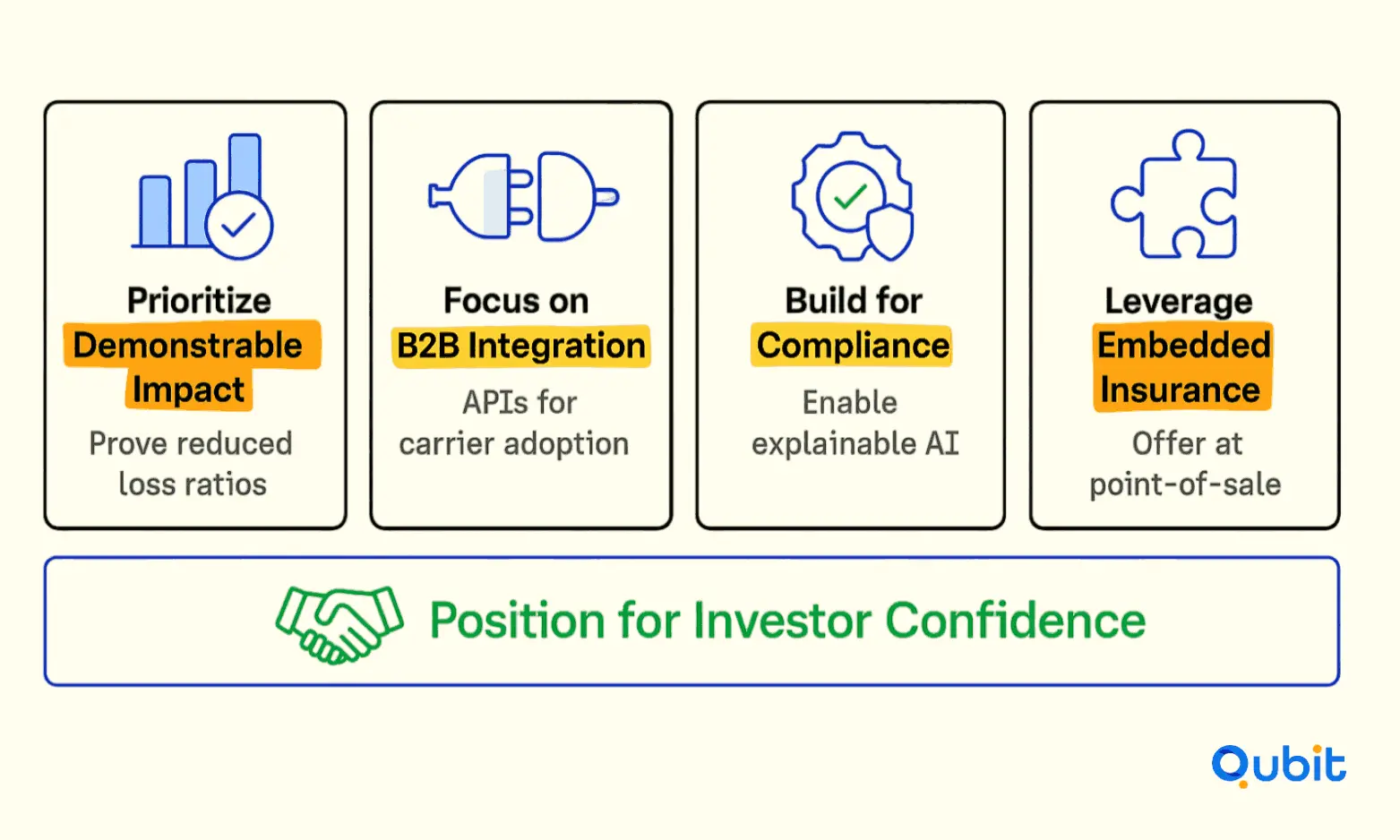As a founder in this space, you should know that AI is no longer just a buzzword, it's the core driver of both capital inflows and strategic partnerships. The most successful insurtechs are those that can prove their technology delivers measurable improvements in automation, pricing, and claims outcomes.
Why AI Is the Magnet for Insurtech Funding
Global insurtech investment surged to $1.31 billion in Q1 2025, a 90.2% jump from the previous quarter, with AI-centric companies capturing 61% of all capital. This is not a temporary spike, but a sustained trend reflecting investor belief in AI’s ability to transform underwriting, risk selection, and customer experience. Property and casualty (P&C) insurtechs dominated, raising $1.13 billion, while B2B technology vendors achieved record market share, accounting for over 61% of P&C deals.
AI’s appeal for investors is simple: it promises scalable automation, sharper risk selection, and lower loss ratios. Predictive analytics, powered by machine learning and big data, are helping carriers and MGAs move from reactive to proactive risk management, an essential advantage in today’s volatile market.
AI Underwriting: The New Gold Standard
AI-driven underwriting platforms are now the gold standard for insurtechs seeking funding. These systems use small language models (SLMs) and advanced algorithms to analyze vast data sets, improving the accuracy and speed of quoting, pricing, and policy issuance. Unlike generic large language models, SLMs are tailored to insurance-specific tasks, delivering higher precision and reliability for complex underwriting scenarios.
Investors are backing startups that can demonstrate:
- Automated risk scoring and triage
- Real-time pricing adjustments based on predictive analytics
- Seamless integration with legacy carrier systems
- Document processing and fraud detection automation
The result? Startups like Quantexa and Instabase secured rounds exceeding $100 million each by showcasing their AI-powered underwriting and analytics capabilities.
Predictive Analytics: From Claims to Customer Retention
Predictive analytics is not just about underwriting; it’s transforming the entire insurance value chain. For insurtechs, the ability to forecast claims frequency, severity, and customer churn is a key differentiator. Investors are especially interested in platforms that can:
- Anticipate losses and optimize reserves
- Identify high-risk customers or policies in real time
- Personalize product offerings and retention strategies
- Reduce manual intervention in claims adjudication
In 2024, AI and machine learning startups attracted $2.5 billion of the $4 billion invested in insurtech, reflecting the sector’s shift toward data-driven innovation. This focus on analytics is also driving up valuation multiples for startups specializing in claims automation and customer insights.
What Early-Stage Insurtech Founders Should Do

1. Prioritize Demonstrable Impact
Investors want proof, not promises. Build case studies that show how your AI models reduce loss ratios, improve pricing accuracy, or cut claims cycle times. Use dashboards and KPIs to quantify your impact.
2. Focus on B2B Integration
B2B insurtechs are attracting the lion’s share of capital, with 61.4% of all P&C deals in Q1 2025 going to vendors that integrate with carrier infrastructure. Develop APIs and workflows that make it easy for insurers to adopt your technology.
3. Build for Compliance and Explainability
Regulators and carriers want AI they can trust. Invest in explainable AI and robust governance frameworks. Document your model development, validation, and monitoring processes. This not only wins investor confidence but also accelerates partnerships with established carriers.
4. Leverage Embedded Insurance
Embedded insurance platforms, where coverage is offered at the point of sale or within another product—are a hotbed for AI innovation. Predictive analytics enables real-time risk assessment and pricing, making embedded models more attractive to investors. For more, see embedded insurance funding.
Benchmark Against Top Trends
Stay updated on what investors are watching. The latest insurtech investment trends highlight AI, embedded insurance, and B2B platforms as the most promising niches. Position your startup at the intersection of these trends for maximum visibility.
Valuation Multiples and Investor Expectations
Insurtech startups leveraging AI and analytics are commanding higher valuation multiples—especially those in marketplaces, data analytics, and claims automation niches. However, investors are increasingly cautious about profitability and scalability. Demonstrate a clear path to sustainable margins and regulatory compliance to maximize your valuation.
Overcoming Challenges in AI Adoption for Insurtech Startups
While AI-driven underwriting and predictive analytics offer massive potential, insurtech startups face several hurdles. Data quality and availability remain top challenges. Many startups struggle to access clean, comprehensive datasets needed to train accurate models. Investors look for startups that have solved or mitigated these issues through partnerships or proprietary data sources.
Another challenge is regulatory uncertainty. AI models must comply with evolving insurance regulations and data privacy laws. Startups that invest in explainable AI and robust governance frameworks reduce regulatory risk and increase investor confidence. Demonstrating a clear compliance roadmap is often a decisive factor in funding rounds.
Finally, integration with legacy insurance systems can be complex. Startups that build flexible, API-driven platforms ease adoption for carriers and brokers, accelerating deployment and scaling. Addressing these challenges head-on positions you as a reliable partner and funding magnet.
The Future Outlook: AI’s Role in Shaping Insurtech Investment
Looking ahead, AI’s role in insurtech funding will only deepen. Investors are increasingly focusing on next-generation AI capabilities such as generative models for risk simulation, reinforcement learning for dynamic pricing, and advanced natural language processing for claims automation.
Startups that pioneer these technologies while maintaining strong compliance and demonstrable ROI will attract premium valuations and strategic partnerships. Moreover, AI-powered embedded insurance platforms will continue to expand, creating new distribution channels and revenue streams.
Conclusion
AI-driven underwriting and predictive analytics have moved from hype to hard results in insurtech funding. Investors are rewarding startups that can automate risk selection, pricing, and claims with capital, higher valuations, and strategic partnerships. As a founder, your focus should be on building explainable, integrated solutions that deliver measurable ROI for carriers and brokers. Stay aligned with investor priorities, document your impact, and position your startup at the forefront of AI innovation to win the next round of funding.
We at Qubit Capital can connect you with the right investors through our Investor Outreach service. Let us help you take the next step toward success in this evolving market.
Key Takeaways
- AI insurtech startups captured 61% of global insurtech funding in Q1 2025.
- Predictive analytics and automated underwriting are the top investor priorities.
- B2B platforms and embedded insurance models are attracting the most capital.
- Demonstrable impact, compliance, and integration are essential for fundraising success.
- Valuation multiples are highest for startups with scalable, data-driven solutions.
Frequently asked Questions
What percentage of insurtech funding went to AI startups in Q1 2025?
AI-focused insurtechs captured 61% of all capital, totaling over $710 million in Q1 2025


 Back
Back



